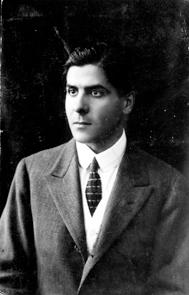English
Josep Maria Junoy (Barcelona, 1887-1955) was an art critic, avant-garde poet and, on occasion, a publisher.
After spending his childhood in La Cerdanya, Junoy travelled to Paris at the age of sixteen with the aim of setting out on a career as an illustrator. Impressed by the avant-garde movements, he returned to Barcelona one year later, now an art critic. He wrote as a columnist for La Publicidad where his brother-in-law Emili held some sway, as well as in La Veu de Catalunya. In 1912 he published Arte & Artistas (Art & Artists) a work clearly marked by the influence of cubism, which was followed in 1917 by Troços (Bits and Pieces), consisting of fragments of art criticism of avant-garde inspiration.
It was Josep Maria Junoy who introduced the calligram form into Catalonia, followed by the Japanese poetic styles of haiku and haikai. His Amour et Paysage (Love and Landscape), a work mainly written in French, appeared in 1920, along with Poemes i cal·ligrames (Poems and Calligrams). The latter work includes the calligram "Oda a Guynemer" (Ode to [the aviator] Guynemer), dated 1917 and considered by Apollinaire to be the first work of art in calligram form.
In 1918 Junoy suffered a crisis of faith that led him to reappraise several intellectual questions. In 1927, he founded the review La Nova Revista in tandem with a publishing house that brought out the work of G. K. Chesterton. Persecuted as a Catholic during the Civil War and victim of reprisals in the post-war years because of his Catalan nationalist stance, Josep Maria Junoy thenceforth wrote his art criticism mainly in Spanish and his work appeared in different media publications and books, mainly concerned with Spanish art.
He died in Barcelona in 1955.
Web page: Abel Ramon Vidal for AELC.
Translation: Juie Wark.
Photo: Obra poética. Barcelona: El Acantilado, 2010.

